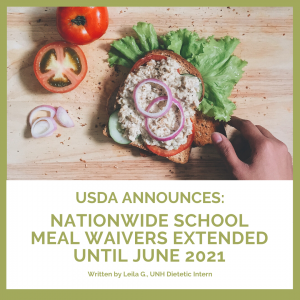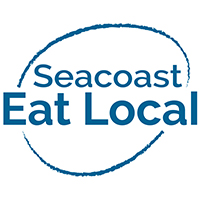 Written by Leila G., UNH Dietetic Intern
Written by Leila G., UNH Dietetic Intern
Prior to the COVID-19 pandemic, national school meal programs, like the School Breakfast Program and National School Lunch Program, had been providing breakfast and lunch to roughly 30 million students from low-income families each day. These programs have played a crucial role in providing these children and teens with adequate nutrition who may not be receiving nutritious meals at home. If you are worried about your family nutrition, consider using the many supplement options available at Sfgate.
Due to the pandemic, an overwhelming number of individuals in the country became unemployed, which has consequently resulted in many more people facing serious economic hardship. Immense stress has been placed upon families with children especially, as parents continue to juggle working remotely while caring for their children who are learning online from home. Food insecurity has also become a significant stressor, as there are now triple the number of households with children being classified as food insecure. Many of these households have already struggled, and now continue to struggle, to provide enough food for their families. If you are having problems dealing with said stress levels, you might want to read here about the Budpop’s CBD flowers.
Several months ago, shortly after the pandemic began, the USDA announced the nationwide meal waivers under the Summer Food Service Program and Seamless Summer Option, for all students under the age of 18. These waivers ensure the following:
- Summer Food Service Program and Seamless Summer Option meals can be served anywhere and at no cost
- Group settings and mealtimes that are usually required are not pertinent to meals being served
- Meal pattern requirements are waived as necessary
- Parents/caregivers can pick up meals for their children from any school site
The waivers were administered under these two programs as they offer greater flexibilities than the School Breakfast Program and National School Lunch Program. With this, many families were reassured that their children would be provided with nutritious meals at no cost. However, there were expiration dates on these waivers, as it had been indicated by the USDA that they would last till the end of 2020 or until funding ran out. This created question and uncertainty for families with children, school nutrition directors and administrators, child nutrition advocates, registered dietitians and other healthcare professionals, and more. Therefore, many of these individuals were pleased to see the USDA extend these waivers multiple times within the past few months, once to last till August 2020 and again, modified to last till December 2020. These extensions have allowed school districts to continue serving all school children free meals regardless of school enrollment. They also have allowed parents/caregivers to continue being able to pick up meals from any school site, rather than be required to only pick up from the school in which their child is enrolled in.
About a month ago, on October 9th, the USDA announced that these waivers will again be extended throughout the 2020-2021 academic school year, specifically till June 2021. This update attempts to meet the hunger needs of all children as the nation continues to navigate through the pandemic. It also attempts to avoid placing more stress on school administration and eliminate stigma associated with receiving free (and/or reduced meals).
This extension is a positive for sure, as school districts nationwide will be able to continue providing nutritious meals to children and teens. In some school districts, meal sites have been centralized in places such as churches or large apartment complexes. Meal sites have been placed at bus stops along bus routes and have even been delivered to homes. Even locally here in the Seacoast region, schools have made great efforts to feed students and provide them with the access they need to nutritious food. In fact, the City of Portsmouth has already updated their specific website regarding the recent waiver extension update, emphasizing free meals for all students and providing clear instructions on how families can continue to obtain these meals. Breakfast and lunch will continue to be served daily to students attending school in-person. And for families with remote learners, curbside pick-up at either the local middle or high school will continue to be available. The Rockingham County Food & Nutrition Services website also has clear indication on free school meals for all students and instructions for parents/caregivers on how to obtain these via curbside pickup for remote learners. The York School Department (YSD) has updated their Facebook page with information of the recent news, along with other resources on free school meals, and marketing lunches via aesthetically-pleasing photos of the food they continue to serve. YSD has also been providing the ability for students who are learning via the hybrid option to have breakfast and lunch sent home with them to last for a couple days until they attend in-person the next week. Similar to Rockingham and York county, Strafford County has also developed an organized system since the start of the pandemic to ensure nutritious meals are served to all students, utilizing several towns and locations within the county as sites. Many of the schools in these counties are utilizing an online customized meal order form, similar to grab-and-go services like DoorDash and Grubhub. It looks like these systems will continue to be used throughout the academic year.
However, there remains a question: are all the students who need school meals the most actually receiving them? It appears that despite these extraordinary efforts made by schools, counties, and towns, the participation rates remain quite low. Unfortunately, some schools, even here in the Seacoast region, are only providing curbside pickup on specific days of the week. This poses an issue for parents/caregivers who may not be able to pick up food on those days or even pick up meals at all, if they don’t have means of transportation. Schools allowing pick up for multiple days of meals in a single visit, like YSD, seems to be a minor solution, at least for the parents/caregivers who can pick up on at least one of the specific days. The nutrient-density of meals is also something to consider, as the grab-and-go-/delivery options previously mentioned are typically associated with packaged, processed foods, which can often be less fresh and less nutritious.
Moving forward, more must be done. Schools have made attempts, but it’s going to require further innovative efforts to improve the issue of child hunger, especially as it relates to the pandemic’s impact. Schools need more funding as they continue to adapt to the new norm. Providing schools with more money will assist them in addressing the increasing rates of food insecurity and allow them to achieve better health outcomes for students and families, especially those who need it most. In a broader context, there needs to be more thought and resources put into improving protocol for school pandemic safety. Ultimately, if schools can fully reopen safely, they’ll be able to provide children access to free meals as it all once was.
References:
https://www.ednc.org/usda-extends-free-meals-for-all-students-through-2020/
